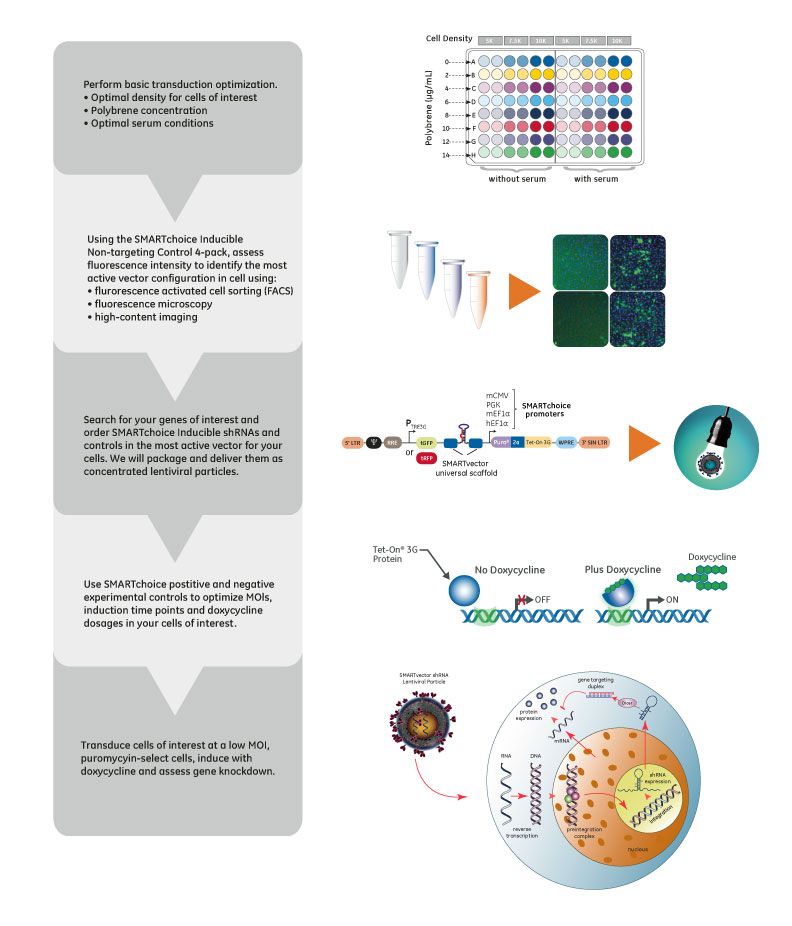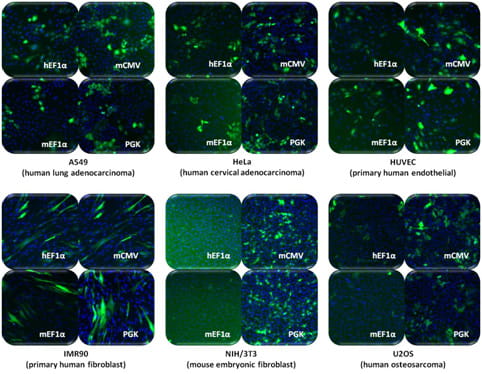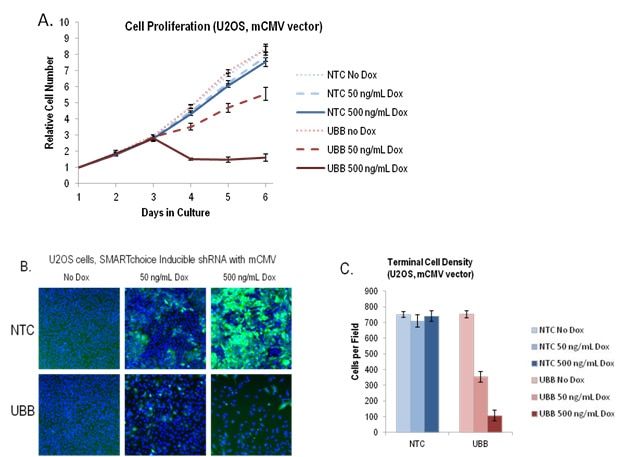- Gene modulation
- RNA interference
- Short hairpin RNA (shRNA)
- SMARTvector Inducible Lentiviral Controls
SMARTvector Inducible Lentiviral Controls
Matched Controls enable accurate data interpretation for both SMARTvector Inducible shRNA and shMIMIC Inducible microRNAs

To order gene-specific SMARTvector Inducible Lentiviral shRNAs or shMIMIC Inducible Lentiviral microRNAs search for your gene of interest and make your desired promoter and reporter choices.
Matched SMARTvector Inducible Negative and Positive RNAi Controls enable accurate data interpretation for both SMARTvector Inducible shRNA and shMIMIC Inducible Lentiviral microRNA
The SMARTvector Inducible RNAi Controls are cost-effective tools for determining optimal conditions for delivery and doxycycline induction, prior to using gene-specific SMARTvector Inducible Lentiviral shRNAs and shMIMIC Inducible Lentiviral microRNAs.
Start by identifying the optimal vector configuration for your cells with the SMARTchoice Inducible Non-targeting Control 4-Pack
Determine the most active promoter in the specific cells of interest by evaluating all four vectors simultaneously using the SMARTchoice Inducible Non-targeting Control 4-Pack (catalog # VSC6847):
- Four aliquots (25 µL each) of SMARTvector Inducible Non-targeting Controls supplied as high-titer, concentrated and purified lentiviral particles
- Includes each SMARTvector Inducible Non-targeting Control with PGK, mouse CMV, human EF1α and mouse EF1α promoters; and with the turboGFP fluorescent reporter
- Enables qualitative, empirical evaluation of optimal promoter driving expression of puromycin resistance and Tet-On 3G transactivator protein
Order SMARTvector inducible RNAi controls with promoter and reporter selections matching your gene-specific constructs.
SMARTvector Inducible vector-matched controls are available with options for all four promoters and two fluorescent reporters or without a fluorescent reporter. All individual controls are available as glycerol stocks and as 50 µL (2 x 25 µL) at 1 x 107 TU/mL, ± 20%, of purified, concentrated packaged lentiviral particles.
SMARTvector Inducible Non-targeting Controls
- Designed so that no known gene in human, mouse or rat is targeted, providing a baseline to which gene-specific effects can be normalized
- Useful for assessing transduction efficiency and the effects of transduction on the cells of interest
Experimental considerations:
- SMARTvector Inducible Non-targeting Control 1: Our longest standing and most commonly used SMARTvector non-targeting control, ideal for supporting most experiments involving only a few genes
- SMARTvector Inducible Non-targeting Control 2 – 12: Designed specifically with the needs of screeners in mind, who may require using several different non-targeting control sequences in follow-up experiments; should be selected if multiple controls are desired
| SMARTvector Inducible RNAi Experimental Control | Reporter | RNA Pol II Promoter | Catalog Number | ||
|---|---|---|---|---|---|
| SMARTvector Inducible Non-targeting Control | TurboGFP | mCMV | VSC6570 | ||
| hEF1α | VSC6572 | ||||
| mEF1α | VSC6574 | ||||
| PGK | VSC6580 | ||||
| TurboRFP | mCMV | VSC6571 | |||
| hEF1α | VSC6573 | ||||
| mEF1α | VSC6575 | ||||
| PGK | VSC6581 | ||||
SMARTvector Inducible Positive Controls
- Permit confirmation of transduction efficiency and gene knockdown through consistent, potent silencing of non-essential, abundantly expressed housekeeping genes
- SMARTvector Inducible GAPD Positive Control shRNA (human, mouse and rat); validated to target glyceraldehyde-3-phosphate dehydrogenase (also known as GAPDH)
- SMARTvector Inducible PPIB Positive Control shRNA (human, mouse and rat); validated to target peptidylprolyl isomerase B (also known as cyclophilin B)
| SMARTvector Inducible RNAi Experimental Control | Reporter | RNA Pol II Promoter | Catalog Number | ||
|---|---|---|---|---|---|
| Human | Mouse | Rat | |||
| SMARTvector Inducible GAPDH Positive Control shRNA | TurboGFP | mCMV | VSH6542 | VSM6390 | VSR6420 |
| hEF1α | VSH6544 | VSM6392 | VSR6422 | ||
| mEF1α | VSH6546 | VSM6394 | VSR6444 | ||
| PGK | VSH6552 | VSM6416 | VSR6446 | ||
| TurboRFP | mCMV | VSH6543 | VSM6391 | VSR6421 | |
| hEF1α | VSH6545 | VSM6393 | VSR6423 | ||
| mEF1α | VSH6547 | VSM6395 | VSR6445 | ||
| PGK | VSH6553 | VSM6417 | VSR6447 | ||
| Human | Mouse | Rat | |||
| SMARTvector Inducible PPIB (Cyclophilin B) Positive Control shRNA | TurboGFP | mCMV | VSH6530 | VSM6562 | VSR6592 |
| hEF1α | VSH6532 | VSM6564 | VSR6727 | ||
| mEF1α | VSH6534 | VSM6576 | VSR6729 | ||
| PGK | VSH6548 | VSM6578 | VSR6731 | ||
| TurboRFP | mCMV | VSH6531 | VSM6563 | VSR6593 | |
| hEF1α | VSH6533 | VSM6565 | VSR6728 | ||
| mEF1α | VSH6535 | VSM6577 | VSR6730 | ||
| PGK | VSH6549 | VSM6579 | VSR6732 | ||
SMARTvector Inducible Lentiviral shRNA Experimental Workflow

The SMARTchoice Inducible shRNA experimental workflow begins with using the SMARTchoice Inducible Non-targeting Control 4-Pack to identify the most active vector configuration in your cells of interest simply by assessing TurboGFP fluorescence intensity in transduced cells. Then, order gene-specific shRNAs and matched-vector positive and negative controls with your choice of RNA polymerase II promoter and reporter. Optimization of doxycycline doses (concentrations) and time points for induction should be performed using positive and negative controls. Transduce cells with SMARTchoice Inducible shRNAs targeting genes of interest, always including matched positive and negative RNAi controls for rigorous data interpretation. All SMARTchoice Inducible shRNAs and RNAi controls are provided as high-titer, purified and concentrated lentiviral particles for immediate transduction.
Elements of the SMARTvector Inducible Lentiviral shRNA Backbone

| Vector Element | Utility |
|---|---|
| 5' LTR | 5' Long Terminal Repeat is necessary for lentiviral particle production and integration of the construct into the host cell genome |
| Ψ | Psi packaging sequence allows lentiviral genome packaging using lentiviral packaging systems |
| RRE | Rev Response Element enhances titer by increasing packaging efficiency of full-length lentiviral genomes |
| TRE3G | Inducible promoter with Tetracycline Response Elements which is activated by the Tet-On 3G protein in the presence of doxycycline |
| tGFP or tRFP | TurboGFP or TurboRFP reporter for visual tracking of transduction and expression upon doxycycline induction |
| SMARTvector universal scaffold | Optimized proprietary scaffold based on native primary microRNA in which gene-targeting sequence is embedded |
| PuroR | Puromycin resistance gene permits antibiotic selection of transduced cells |
| 2A | Self-cleaving peptide that enables the expression of both PuroR and Tet-On 3G transactivator from a single RNA pol II promoter |
| Tet-On 3G | Encodes the doxycycline-regulated transactivator protein, which binds to TRE3G only in the presence of doxycycline |
| WPRE | Woodchuck Hepatitis Post-transcriptional Regulatory Element enhances transgene expression in target cells |
| 3' SIN LTR | 3' Self-inactivating Long Terminal Repeat for generation of replication-incompetent lentiviral particles |
SMARTvector Inducible Lentiviral shRNA promoter activities differ across cell types.

SMARTvector Inducible Lentiviral shRNA Non-targeting Controls were used to transduce the indicated cell types at MOI = 0.3. 24 h after transduction, expression of the non-targeting shRNA and PuroR was induced with 1 µg/mL doxycycline. After 48 h of culture in the presence of doxycycline, cells were stained with Hoescht-33342 and nuclei (blue) and TurboGFP (green) were imaged. While ~30% of the cells in the field have been transduced, some images may appear to contain fewer than 30% TurboGFP-positive cells due to low TurboGFP expression, indicative of low constitutive promoter activity, in a particular cell type.
SMARTvector Inducible Lentiviral shRNAs enable tightly controlled knockdown of essential genes in a time- and doxycycline dose-dependent manner

A. U2OS cells were transduced at MOI = 0.1 with SMARTvector Inducible Lentiviral mCMV vectors carrying either a non-targeting control shRNA (NTC) or an shRNA directed against the ubiquitin B (UBB) gene. Cells were selected for 3 days with 1.5 µg/mL puromycin. After selection, cells were seeded at 2000 cells per/well in 96-well plates. 24 hours later (Day 1), shRNA expression was induced with the indicated dose of doxycycline, and cell number was then measured each day with the Cell Titer-Glo assay (Promega). Each data point represents the mean and standard deviation of six independent wells. B. On Day 6, following 5 days of exposure to doxycycline, the cells were stained with Hoescht 33342 and cell nuclei (blue) and TurboGFP (green) were imaged on the ArrayScan VTI HCS Reader. C. Cell density, defined as number of nuclei per field was computed for 18 fields per condition.
